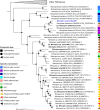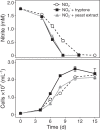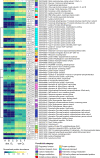Metabolic versatility of the nitrite-oxidizing bacterium Nitrospira marina and its proteomic response to oxygen-limited conditions
- PMID: 33230266
- PMCID: PMC8115632
- DOI: 10.1038/s41396-020-00828-3
Metabolic versatility of the nitrite-oxidizing bacterium Nitrospira marina and its proteomic response to oxygen-limited conditions
Abstract
The genus Nitrospira is the most widespread group of nitrite-oxidizing bacteria and thrives in diverse natural and engineered ecosystems. Nitrospira marina Nb-295T was isolated from the ocean over 30 years ago; however, its genome has not yet been analyzed. Here, we investigated the metabolic potential of N. marina based on its complete genome sequence and performed physiological experiments to test genome-derived hypotheses. Our data confirm that N. marina benefits from additions of undefined organic carbon substrates, has adaptations to resist oxidative, osmotic, and UV light-induced stress and low dissolved pCO2, and requires exogenous vitamin B12. In addition, N. marina is able to grow chemoorganotrophically on formate, and is thus not an obligate chemolithoautotroph. We further investigated the proteomic response of N. marina to low (∼5.6 µM) O2 concentrations. The abundance of a potentially more efficient CO2-fixing pyruvate:ferredoxin oxidoreductase (POR) complex and a high-affinity cbb3-type terminal oxidase increased under O2 limitation, suggesting a role in sustaining nitrite oxidation-driven autotrophy. This putatively more O2-sensitive POR complex might be protected from oxidative damage by Cu/Zn-binding superoxide dismutase, which also increased in abundance under low O2 conditions. Furthermore, the upregulation of proteins involved in alternative energy metabolisms, including Group 3b [NiFe] hydrogenase and formate dehydrogenase, indicate a high metabolic versatility to survive conditions unfavorable for aerobic nitrite oxidation. In summary, the genome and proteome of the first marine Nitrospira isolate identifies adaptations to life in the oxic ocean and provides insights into the metabolic diversity and niche differentiation of NOB in marine environments.
Conflict of interest statement
The authors declare that they have no conflict of interest.
Figures






References
-
- Gruber N. The marine nitrogen cycle: Overview and challenges. In: G Capone, DA Bronk, MR Mulholland, EJ Carpenter (eds). Nitrogen in the marine environment, 2nd ed. Academic Press: New York, NY, 2008, pp. 1–50.
-
- Watson SW, Bock E, Valois FW, Waterbury JB, Schlosser U. Nitrospira marina gen. nov. sp. nov.: a chemolithotrophic nitrite-oxidizing bacterium. Arch Microbiol. 1986;144:1–7. doi: 10.1007/BF00454947. - DOI

